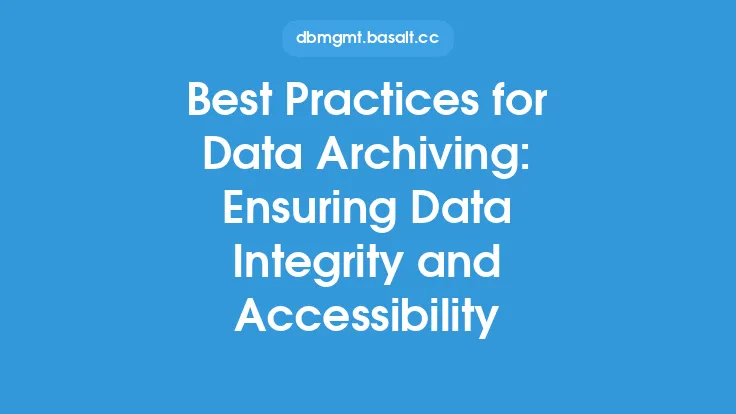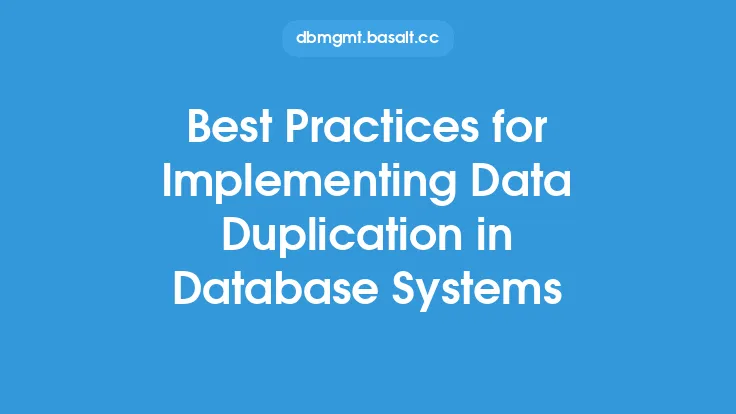As a database administrator, ensuring data integrity is a critical aspect of maintaining a reliable and trustworthy database. Data integrity refers to the accuracy, completeness, and consistency of data within a database. It is essential to implement best practices to ensure data integrity, which in turn, helps to maintain compliance with regulatory requirements. In this article, we will discuss the compliance best practices for database administrators to ensure data integrity.
Understanding Data Integrity
Data integrity is a broad concept that encompasses several aspects, including data accuracy, data completeness, and data consistency. Data accuracy refers to the correctness of data, ensuring that it is free from errors and inconsistencies. Data completeness refers to the availability of all required data, ensuring that no data is missing or incomplete. Data consistency refers to the uniformity of data, ensuring that data is consistent across the database. Ensuring data integrity is crucial, as it directly impacts the reliability and trustworthiness of the database.
Data Validation and Verification
Data validation and verification are critical components of ensuring data integrity. Data validation refers to the process of checking data for accuracy and completeness before it is entered into the database. This can be achieved through various techniques, such as data type checking, range checking, and format checking. Data verification, on the other hand, refers to the process of checking data for accuracy and completeness after it has been entered into the database. This can be achieved through various techniques, such as data reconciliation, data comparison, and data auditing. Database administrators can implement data validation and verification techniques using database constraints, triggers, and stored procedures.
Database Constraints
Database constraints are rules that are applied to data within a database to ensure data integrity. There are several types of database constraints, including primary key constraints, foreign key constraints, unique constraints, and check constraints. Primary key constraints ensure that each row in a table has a unique identifier. Foreign key constraints ensure that relationships between tables are maintained. Unique constraints ensure that each value in a column is unique. Check constraints ensure that data meets specific conditions. Database administrators can use database constraints to enforce data integrity and prevent data inconsistencies.
Data Normalization
Data normalization is the process of organizing data in a database to minimize data redundancy and improve data integrity. Data normalization involves dividing large tables into smaller tables and defining relationships between them. This helps to eliminate data redundancy, improve data consistency, and reduce data anomalies. Database administrators can use various normalization techniques, such as first normal form (1NF), second normal form (2NF), and third normal form (3NF), to normalize data and improve data integrity.
Transaction Management
Transaction management is critical to ensuring data integrity in a database. A transaction is a sequence of operations that are executed as a single, all-or-nothing unit of work. Transaction management ensures that database transactions are executed reliably and securely, maintaining data consistency and preventing data corruption. Database administrators can use various transaction management techniques, such as commit and rollback, to manage transactions and ensure data integrity.
Backup and Recovery
Backup and recovery are essential components of ensuring data integrity in a database. Backup refers to the process of creating a copy of data, while recovery refers to the process of restoring data from a backup. Database administrators can use various backup and recovery techniques, such as full backups, incremental backups, and differential backups, to ensure data integrity and prevent data loss. Regular backups and recovery procedures help to ensure that data is available and accessible, even in the event of a disaster or data corruption.
Change Management
Change management is critical to ensuring data integrity in a database. Change management refers to the process of managing changes to the database, including changes to data, schema, and configuration. Database administrators can use various change management techniques, such as version control, to manage changes and ensure data integrity. Change management helps to prevent unauthorized changes, ensure data consistency, and maintain data integrity.
Auditing and Logging
Auditing and logging are essential components of ensuring data integrity in a database. Auditing refers to the process of tracking and monitoring database activities, while logging refers to the process of recording database events. Database administrators can use various auditing and logging techniques, such as database auditing tools and log analysis software, to track and monitor database activities, detect security breaches, and prevent data corruption.
Best Practices for Database Administrators
To ensure data integrity, database administrators should follow best practices, including:
- Implementing data validation and verification techniques
- Using database constraints to enforce data integrity
- Normalizing data to minimize data redundancy and improve data consistency
- Managing transactions to ensure data consistency and prevent data corruption
- Regularly backing up and recovering data to prevent data loss
- Managing changes to the database to prevent unauthorized changes and ensure data consistency
- Auditing and logging database activities to detect security breaches and prevent data corruption
By following these best practices, database administrators can ensure data integrity, maintain compliance with regulatory requirements, and provide a reliable and trustworthy database for users.
Conclusion
Ensuring data integrity is a critical aspect of database administration, and it requires a comprehensive approach that includes data validation and verification, database constraints, data normalization, transaction management, backup and recovery, change management, and auditing and logging. By following best practices and using various techniques and tools, database administrators can ensure data integrity, maintain compliance with regulatory requirements, and provide a reliable and trustworthy database for users. As data continues to play an increasingly important role in business and society, ensuring data integrity will become even more critical, and database administrators must be prepared to meet the challenge.





